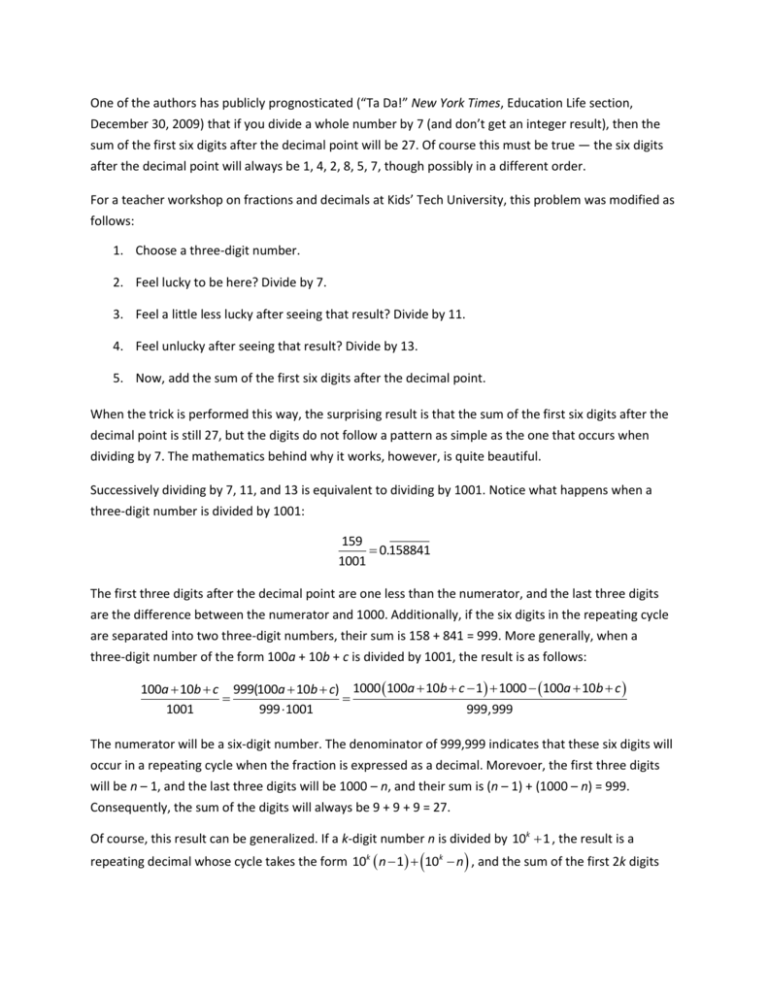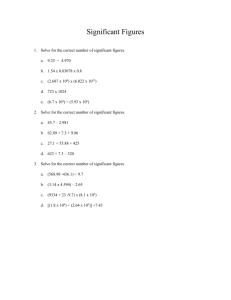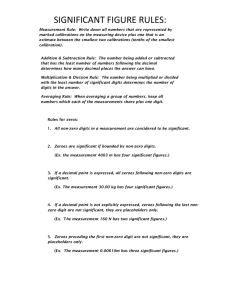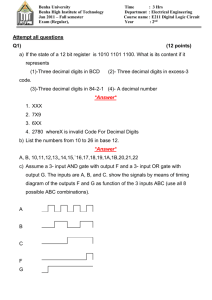Word file - Harvey Mudd College Department of Mathematics
advertisement

One of the authors has publicly prognosticated (“Ta Da!” New York Times, Education Life section, December 30, 2009) that if you divide a whole number by 7 (and don’t get an integer result), then the sum of the first six digits after the decimal point will be 27. Of course this must be true — the six digits after the decimal point will always be 1, 4, 2, 8, 5, 7, though possibly in a different order. For a teacher workshop on fractions and decimals at Kids’ Tech University, this problem was modified as follows: 1. Choose a three-digit number. 2. Feel lucky to be here? Divide by 7. 3. Feel a little less lucky after seeing that result? Divide by 11. 4. Feel unlucky after seeing that result? Divide by 13. 5. Now, add the sum of the first six digits after the decimal point. When the trick is performed this way, the surprising result is that the sum of the first six digits after the decimal point is still 27, but the digits do not follow a pattern as simple as the one that occurs when dividing by 7. The mathematics behind why it works, however, is quite beautiful. Successively dividing by 7, 11, and 13 is equivalent to dividing by 1001. Notice what happens when a three-digit number is divided by 1001: 159 0.158841 1001 The first three digits after the decimal point are one less than the numerator, and the last three digits are the difference between the numerator and 1000. Additionally, if the six digits in the repeating cycle are separated into two three-digit numbers, their sum is 158 + 841 = 999. More generally, when a three-digit number of the form 100a + 10b + c is divided by 1001, the result is as follows: 100a 10b c 999(100a 10b c) 1000 100a 10b c 1 1000 100a 10b c 1001 999 1001 999,999 The numerator will be a six-digit number. The denominator of 999,999 indicates that these six digits will occur in a repeating cycle when the fraction is expressed as a decimal. Morevoer, the first three digits will be n – 1, and the last three digits will be 1000 – n, and their sum is (n – 1) + (1000 – n) = 999. Consequently, the sum of the digits will always be 9 + 9 + 9 = 27. Of course, this result can be generalized. If a k-digit number n is divided by 10k 1 , the result is a repeating decimal whose cycle takes the form 10k n 1 10k n , and the sum of the first 2k digits after the decimal point is 9k. For instance, if n = 123,456, then k = 6, n – 1 = 123,455, 10k – n = 876,544, and 9k = 54. Consequently, 123,456 0.123455876544 1,000,001 and 1 + 2 + 3 + 4 + 5 + 5 + 8 + 7 + 6 + 5 + 4 + 4 = 54. Problems #X and #Y in this month’s calendar are based on this idea. Patrick Vennebush pvennebush@nctm.org Arthur Benjamin Harvey Mudd College benjamin@math.hmc.edu PROBLEMS FOR THE CALENDAR: Choose a three-digit number. Divide by 7. Divide the result by 11. Divide the result by 13. What is the sum of the first six digits after the decimal point? 27. Dividing by 7, 11, and 13 in succession is equivalent to dividing by 1001. When a three-digit number is divided by 1001, the result is a repeating decimal with a cycle of six digits that takes the form 0.abcdef , and it is always the case that abc + def = 999. Take a k-digit integer n, and then convert n/(10k + 1) to decimal form. In terms of k, what is the sum of the first 2k digits after the decimal point? 9k. If a k-digit number n is divided by 10k 1 , the result is a repeating decimal whose cycle takes the form 10k n 1 10k n . This implies that the first k digits after the decimal point will be n – 1, and the next k digits will be 10k – n, and their sum is 10k – 1. This is equal to the k-digit number 999…999. For example, if n = 123,456, then k = 6, n – 1 = 123,455, 10k – n = 876,544, and 123,456 0.123455876544 1,000,001 Because 123,455 + 876,544 = 999,999, the sum of the digits is 9k = 54.








